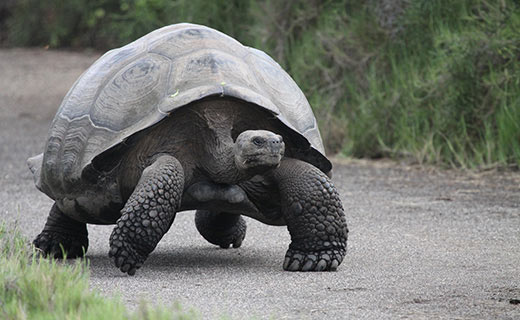Galapagos Islands Point of Difference for Toi Ohomai Graduates

Friday, 20 Sep 2019
How do three weeks in South America and the Galapagos sound? What if we throw in an opportunity to hang on the same island as the near-extinct Giant Fenandina giant tortoise and a a chance to spend time at a turtle breeding grounds?
If you sign up to do the Tropical Ecology and Monitoring elective as part of the New Zealand Diploma in Environmental Management (Level 6), you can join the trip to the Galapagos Islands in early 2021 or wait to go to Namibia in late 2021.
Toi Ohomai Marine and Environmental Programme Manager Dean Tully says the Tropical Ecology and Monitoring elective was added to the diploma because it provides graduates with wildlife conservation skills that will benefit the world.
“New Zealand is often portrayed as a leader in the wildlife conservation field, but are we doing as well as we should? Do we have the best strategies in place to manage our already high tourism numbers? What do other countries do better or different from us?
“The course aims to provide learners with the knowledge and understanding of the biology and ecology of selected tropical marine and terrestrial species, and to be able to undertake appropriate biological monitoring in selected tropical biomes. Learners will also gain knowledge and understanding of selected conservation and wildlife tourism strategies employed in the tropical environment.
“Students get to visit two of the biological hotspots in the world, they get to experience different cultures and languages, survey in these unique environments and learn different monitoring techniques, complete voluntary conservation work, bring other conservation methods and ideas back to New Zealand, have a point of difference on their curriculum vitae.
“The knowledge and skills gained on this course will equip you to take advantage of employment opportunities in various exotic locations or bring different conservation and tourism strategies back to New Zealand.”
Dean says the institute rotates the trips each year.
“The Galapagos trip would be for three and a half weeks somewhere in the November to early February timeframe – with January 2021 likely to be when we go on our first trip. The plan would be travel to Guayaquil in Ecuador and spend three days recovering and visiting Iguana Park and the Malecon.
“Then, we’ll fly to Santa Cruz Island in the Galapagos for six days. We’ll then either hop across to Isabella Island for six days or go on a six-day cruise around the Western Islands, where the cold Humbolt Current enables penguins, flightless cormorants and fur seals to survive on the equator alongside marine iguanas, giant tortoises and turtles.
“Finally, we head across to San Cristobal Island for six days alongside Galapagos sea lions, blue and red-footed boobies and hopefully hammerhead sharks. During this trip, there will be opportunities to examine the work of different conservation organisations and potentially even assist in their research.”
Dean says later in the year, students could travel to Namibia, where they will be able to eat their breakfast while watching lions and elephants, help out in a cheetah rehabilitation centre and explore the Skeleton Coast.
He says preference for the trips will be given to those who have already completed the first year of the diploma. Students are welcome to do both trips, although they would have to cover the cost of each themselves.
The cost of the trip is about $6000 and must be covered by the students, but fundraising is encouraged.
